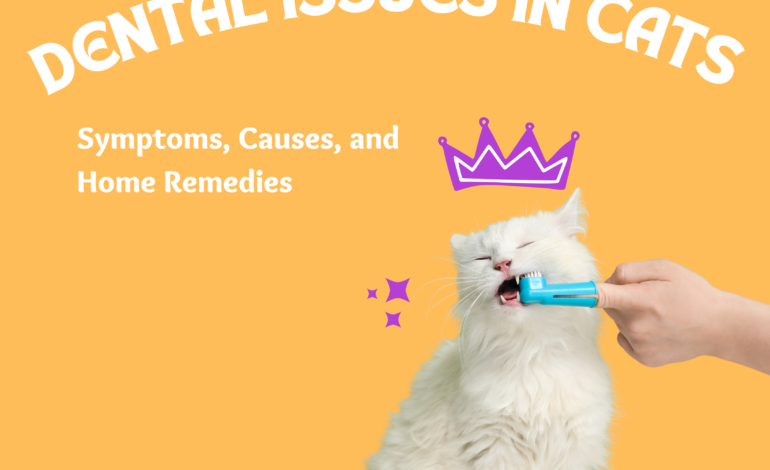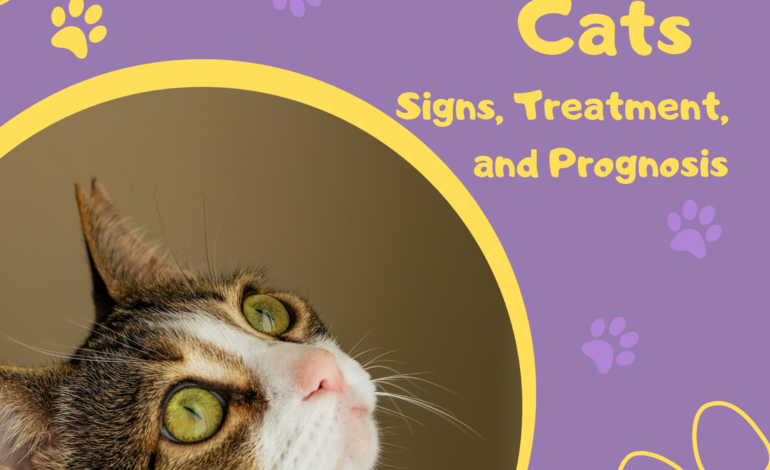Dental Issues in Cats: Symptoms, Causes, and Home Remedies

Did you know that studies report between 50% and 90% of cats over four years old suffer from some form of dental disease? (1)
Many of us don’t notice dental disease in cats because our feline friends are masters at hiding pain. They’ll keep eating, grooming, and acting “normal,” even when their mouth is uncomfortable or hurting.
That’s why it’s so important to pay attention to even small changes — the signs of dental disease in cats — and seek professional care early. Doing so can prevent worse problems later, help keep your cat comfortable, and protect their overall health.
Why Cat Dental Health Matters

Teeth and gums work more than overtime on your cat’s kibble-crunching — they’re a frontline health defense. Oral issues, such as periodontal disease, tooth resorption or stomatitis are more than just painful; they all allow bacteria and inflammation to hit the bloodstream, causing greater strain on major organs. It even associates moderate-severe dental disease with increased risk of chronic kidney disease (CKD) as well as systemic inflammation in cats.
Some dental issues are more common than you think. Tooth resorption, for instance, occurs in 30–60% of cats depending on the study you read; chronic gingivostomatitis — one of the most painful oral diseases a cat can get — can affect one in four cats. (2) Both disrupt eating, grooming and daily comfort, frequently long before owners are aware that something is amiss.
What Most Cat Parents Overlook
- Mouth ↔ Body Connection: Ongoing gum inflammation raises blood markers of disease and can damage organs like the kidneys and heart. Think of it as a slow leak — invisible at first but harmful over time.
- Texture Matters: How your cat eats affects plaque buildup. Wet food, broths, and food puzzles not only boost hydration but may help reduce tartar compared to dry-only diets. Still, no diet replaces professional cleanings and brushing at home.
- X-Rays Reveal the Hidden Story: Many painful issues hide below the gumline. Full-mouth dental radiographs — recommended by specialists — often uncover problems that a surface exam can miss, allowing earlier treatment and fewer extractions.
Signs of Dental Disease in Cats

Cats are experts at hiding pain, so the first clues are often easy to miss. Here are some red flags to watch for:
- Bad breath (halitosis): Often the very first warning sign of periodontal disease.
- Difficulty eating or dropping food: Cats may quietly chew on just one side to avoid a sore tooth.
- Excessive drooling, sometimes with blood: A clear indicator that something in the mouth isn’t right.
- Red, swollen, or bleeding gums; visible tartar: Classic signs of gingivitis or more advanced periodontal disease.
- Changes in grooming, appetite, or weight: Cats with sore mouths may stop grooming and slowly lose weight, sometimes before obvious pain is noticed.
- Loose or missing teeth: Advanced dental disease or tooth resorption; many of these painful lesions hide below the gumline and are only visible on x-rays.
💡 Owner tips:
- The one-side chew test: Offer a crunchy treat — if your cat suddenly favors one side, it may signal a painful tooth.
- Breath & paw check: A quick weekly sniff and watching for pawing at the mouth or rubbing on furniture can reveal subtle discomfort.
- Weigh and watch grooming: Track monthly weight and coat care — small declines often show up weeks before dramatic symptoms.
👉 Dental disease is one of the most common feline health issues, affecting 50–90% of cats over age four. Early detection doesn’t just prevent pain — it protects your cat’s long-term health.
Causes of Dental Disease in Cats

Most dental problems in cats start with plaque, a sticky film of bacteria that coats the teeth. If it isn’t brushed away, it hardens into tartar, creating the perfect home for infection. From there, several conditions can develop:
- Gingivitis: Early gum inflammation triggered by plaque buildup along the gumline. It’s reversible with proper care if caught early.
- Periodontitis: When gingivitis progresses, the infection damages deeper tissues and bone, which can eventually cause tooth loss.
- Tooth Resorption: One of the most painful yet overlooked conditions — the tooth begins breaking down from within. Radiographic studies show it affects 30–60% of cats over age five, even when teeth look normal on the surface.
- Cat Cavities? True cavities are extremely rare in cats, but resorptive lesions often mimic them — which is why dental x-rays are so important for diagnosis.
- Other Risk Factors: Genetics (Persians and Siamese are more prone), age, soft or sticky diets, viral infections like FIV/FeLV, and lack of regular dental care.
💡 Unique note: Unlike humans, cats don’t usually get cavities from sugar. Instead, their biggest threat is resorption, which hides below the gumline — meaning even the most attentive cat parent can miss it without professional dental exams.
Cat Teeth Problems and Home Remedies

There’s no true substitute for a professional veterinary cleaning, but smart home care can go a long way in preventing dental disease before it becomes painful. Think of these as “daily maintenance,” not cures.
Brushing: The Gold Standard
- Use a cat-specific toothbrush or finger brush — never human brushes.
- Only use feline-safe toothpaste (fluoride in human toothpaste is toxic to cats).
- Start slow: let your cat lick the toothpaste first, then gradually introduce brushing.
When Brushing Isn’t Possible
Not every cat tolerates brushing — and that’s okay. There are safe alternatives backed by the Veterinary Oral Health Council (VOHC):
- VOHC-approved treats & diets – proven to reduce plaque and tartar.
- Dental wipes – an easy option for cats who won’t accept brushing.
- Water additives & oral gels – freshen breath and help reduce bacteria.
- Special dental kibble – designed with texture that scrapes teeth.
- Chew toys – not just playtime, but gentle gum stimulation and plaque control.
⚠️ Important: These steps help maintain oral hygiene, but they can’t treat advanced disease. If your cat already has bad breath, bleeding gums, or loose teeth, home care won’t reverse it — only a vet can.
💡 Unique tip: Routine home care also helps your cat get used to mouth handling, which makes future vet exams and dental cleanings far less stressful.
The Limits of Home Remedies
Home care is effective for prevention, but there are clear limits. And once plaque has hardened into tartar, brushing, wipes and water additives won’t take it away — only a professional dental cleaning done under anesthesia can eliminate the popcorn.
Several health problems are out of stay for home remedies, including periodontitis, tooth resorption or chronic gingivostomatitis. These diseases are frequently silent until they are advanced and require specialized veterinary care.
Another key point: dental X-rays. Many of the most painful issues are buried under the gumline and therefore remain out of sight. It’s only through full-mouth radiographs that these problems can be discovered, and only a vet is able to take them.
⚠️ Waiting to get professional care doesn’t just gain you time — it makes your pain last longer and lets disease spread. Treating early also makes your cat more comfortable and may help you avoid extractions later on.
Cat Dental Disease Treatment
When home care isn’t enough — and it often isn’t once disease has set in — veterinarians step in with treatment options tailored to your cat’s needs:
- Professional dental cleanings: Performed under anesthesia to safely remove tartar above and below the gumline.
- Tooth extractions: Sometimes the only way to relieve pain from advanced periodontitis or tooth resorption.
- Antibiotics: Used to control secondary infections, though they don’t cure the underlying dental disease.
- Pain management: Cats are stoic, but dental pain is real — vets may prescribe medications to keep your cat comfortable.
- Regular follow-up exams: Essential for monitoring healing and catching new problems early.
- Dental sealants: In select cases, vets may apply protective coatings that make it harder for plaque to stick to teeth — not a cure, but an extra layer of defense after cleaning.
- Immunomodulatory therapy: For severe cases like chronic gingivostomatitis, some cats benefit from medications that calm an overactive immune response. In rare, stubborn cases, advanced options such as interferon or even stem-cell therapy are being studied.
⚠️ Important: Every cat’s mouth is different. What looks like a “bad tooth” at home could be resorption, gingivostomatitis, or another condition requiring a specific treatment plan. Only a vet can tell the difference.
Prevention: Keeping Your Cat’s Mouth Healthy

The best way to fight dental disease is to stop it before it starts. Since studies show that over 70% of cats develop some form of dental disease by age three, prevention is not optional — it’s essential.
Here are simple, vet-approved steps that make a big difference:
- Brush daily (or as often as possible): Even a few times a week can significantly cut plaque buildup. Use only cat-safe toothpaste.
- VOHC-approved dental treats or diets: Look for the VOHC seal — it’s proof that a product has been clinically tested to reduce plaque and tartar.
- Schedule yearly vet exams and dental cleanings: Most dental disease hides below the gumline; regular exams and cleanings are the only way to catch it early.
- Watch subtle changes: Less grooming, bad breath, chewing on one side, or pawing at the mouth can be early red flags.
- Start young: Kittens that get used to tooth brushing are far more likely to tolerate it as adults — prevention is easiest if it becomes routine early.
💡 Unique tip: Cats who eat from puzzle feeders or water-rich diets often have healthier mouths. The extra hydration and mechanical chewing help support gum and tooth health, though they don’t replace brushing or vet care.
Conclusion
Every purr hides a story — but when dental disease strikes, that story can turn painful without you even realizing it.
Your cat can’t tell you when their mouth hurts — but you can spot the clues and act early. Dental disease in cats is common, yet with simple habits like brushing, regular vet checkups, and watching for subtle changes, you can prevent a lot of pain and protect their long-term health. Remember, a healthy mouth doesn’t just mean fresher breath — it means a cat who eats better, grooms happily, and enjoys life more.
👉 Takeaway: Don’t wait for obvious signs. Start small, stay consistent, and partner with your vet — your cat’s smile (and overall health) will thank you.
Looking for more practical guidance? Meow Care Hub is here to support you with trusted tips and resources to keep your feline friend healthy and happy at every stage of life.
FAQs About Cat Dental Issues
1. What are the early signs of dental disease in cats?
Bad breath, difficulty eating, drooling, and red or swollen gums are common early signs.
2. Do cats get cavities?
True cat cavities are rare. Most cases diagnosed as “cavities” are actually tooth resorption.
3. Can I treat my cat’s dental problems at home?
You can prevent plaque with brushing, dental diets, and VOHC-approved products, but existing disease requires professional veterinary treatment.
4. How do vets treat dental disease in cats?
Cat dental disease treatment may include dental cleanings, extractions, antibiotics, and pain relief.
5. What’s the best home remedy for cat teeth problems?
Daily brushing with feline-safe toothpaste is the most effective prevention method.
6. How often should cats get their teeth checked?
At least once a year, but senior cats or those with a history of oral problems in cats may need more frequent exams.
Resources:





